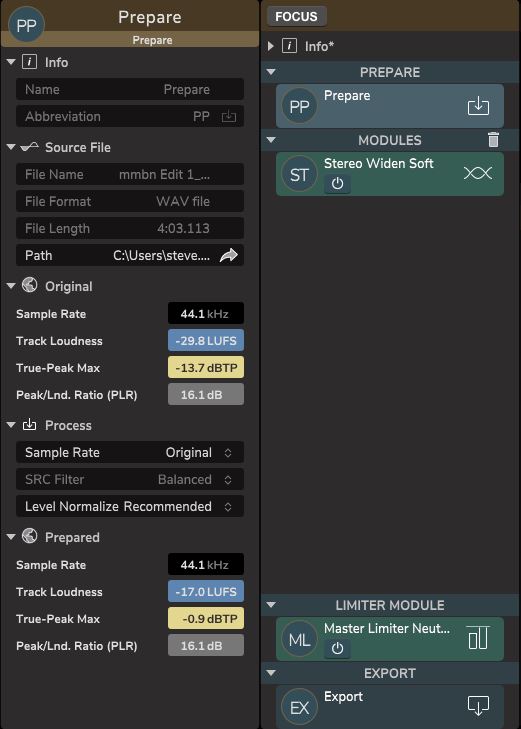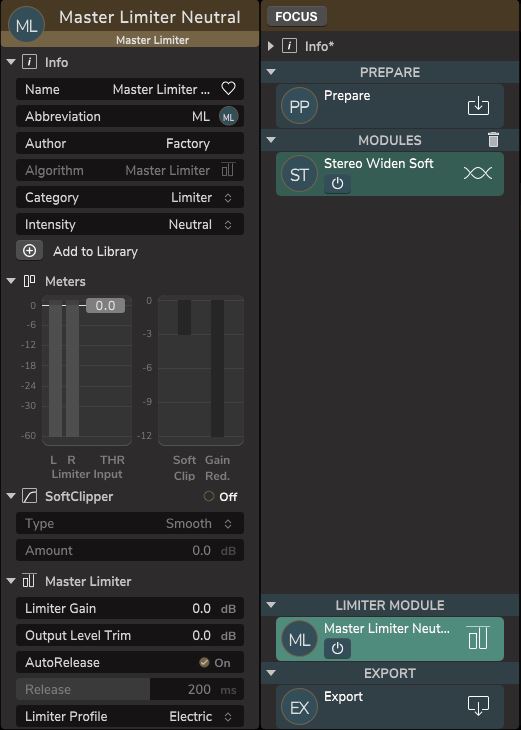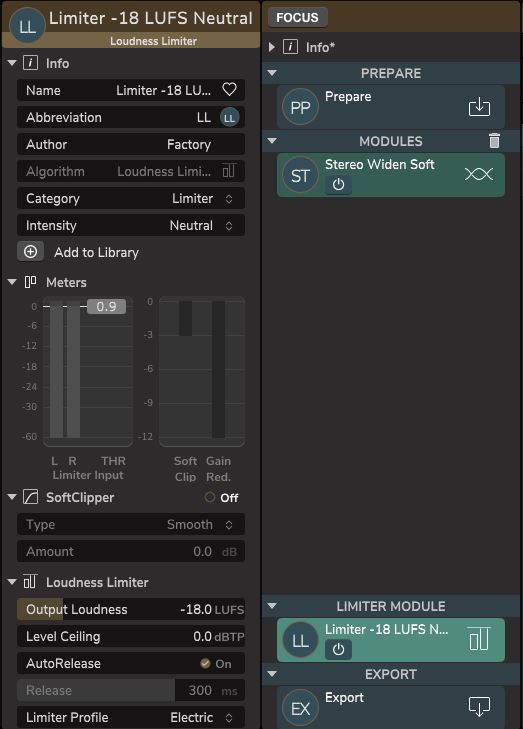Finalizer
Analyzer
Algorithms In Depth
In this section we provide some further details of the algorithms in the processing modules. For details on the SPECTRO LAB, refer to the SPECTRO LAB In Depth chapter.
Prepare
The Prepare module is always included in Finalizer projects, and its job is to prepare the source track for the mastering process. The Prepare module settings are not saved in the Module Chains to the Library, but they are saved in Finalizer project files.

Parameters include:
- Info Section: The name of the Module (Prepare) and its abbreviation (PP) and logo.
- Source File Section: The file name of the current audio source file, its audio format (WAV for example), file length (minutes, seconds), and the path where it is stored.
- Original Section: The original sample rate in kHz, original source file measurements: Track Loudness in LUFS, True Peak Max in dBTP and PLR (Peak to Loudness Ratio) in dB.
- Process Section:
- Sample Rate: This is the project sample rate and can be either identical to the source file (original) or be forced to 44.1 or 48 kHz. The project sample rate is also shown in the Monitor Out Section in the top right of the screen.
- SRC Filter: If the project sample rate is identical to the source file’s sample rate, the Sample Rate Conversion Filter is not applied. When the project sample rate is different than the source file sample rate, a High-Quality FIR conversion filter is applied. This filter features virtually infinite headroom and no noise or L-R imbalance. Available filter settings are, depending on the desired frequency response:
- Steep: is defined by a very steep response towards Nyquist, that is, a “brickwall” filter
- Short; has the lowest filter order of the three, and has very little pre-ringing
- Balanced: is a balanced filter design between the two above. When in doubt, this is a good default setting
- Level Normalize: This is where you “pre-gain” the source file to set an appropriate working level. The gain is set using the background analysis, so it can be automatically normalized (Level Normalize) to a specific full track loudness level. This is a very nice way to work, and it fits the overall approach of a constant and calibrated monitoring level perfectly.
The available normalize settings are:
- Original: will keep the source file as it is and not add pre-gain to it.
- -12, -16, -20 LUFS: will normalize the source file to the chosen full track loudness level. A dynamic track may be normalized to -20 LUFS and a less dynamic mix may be normalized to -12 LUFS.
- Recommended: will choose the loudness level (between -12 to -20 LUFS) that fits the source track best, while leaving headroom for all peaks, and making it optimally fit the monitor output path.
- Prepared Section: This shows the resulting source file measurements after SRC and Normalize processing. The resulting Prepared loudness and True-Peak level can also be seen in the Master Meter A-section.
Note: Should you experience temporary clipping in the monitor output path, you can eliminate this using the Monitor output Fader. If you experience multiple or nearly continuous clipping in the monitor path, you may consider lowering the Normalize Level in the Prepare module and this way reserve more margin in the monitor path while you work.
Parametric EQs
The Parametric EQs feature a high resolution, double precision, infinite headroom, IIR filter implementation, with these available forms:
Single band parametric EQ
- Bell
- Low shelf
- High shelf
- Low cut
- High cut
Parameters include:
- Frequency: 20.00 Hz to 20.00 kHz
- Gain: -18.0 to +18.0 dB
- Bandwidth: 0.2 to 4.0 Octaves (Bell)
- Slope: 3, 6, 9, 12 dB/oct, (High Shelf and Low Shelf)
- Filter Type: Butterworth or Bessel (High Cut and Low Cut)
5 band parametric EQ is a set of 5 EQs that are typically useful in a project.
- Low cut
- 3X Bell
- High shelf
- Band On/Off
Parameters include:
- Frequency: 20.00 Hz to 20.00 kHz
- Gain: -18.0 to +18.0 dB
- Bandwidth: 0.2 to 4.0 Octaves (3X Bell)
- Slope: 3, 6, 9, 12 dB/oct, (High Shelf)
- Filter Type: Butterworth or Bessel (Low Cut)
TC Electronic has a long history of making high-end EQs for mastering. Beside the original Finalizer, introduced in 1995, the Mastering 6000, TC1140, TC1128 and EQ Station are among the most famous products featuring high-end EQs.
Use the Parametric EQs in Finalizer to fine-tune the tonal balance of the mix. The Finalizer EQs, due to high resolution, double precision and infinite headroom, are very transparent and can be used with both broad and surgical settings that are ideal for manipulating the balance of the frequencies. All filters are well-behaved both at low frequencies and near the Nyquist rate.
Single Band Dynamic EQ
The single band Dynamic EQs feature a high resolution, double precision, infinite headroom, IIR filter implementation with the following available parameters:
- Frequency: 20.00 Hz to 20.00 kHz
- Bandwidth: 0.2 to 4.0 Octaves
- Threshold: 0.0 to –60.0 dB
- Max gain reduction: 0.0 to –18.0 dB
- Ratio: 1.00:1 to Infinity:1
- Attack: 0.1 to 200 ms
- Release: 5 to 1500 ms
- Gain reduction meters: 0.0 to –18.0 dB
Note that the Dynamic EQ features Ratio as well as Max gain reduction, which adds to making the Dynamic EQ an even more flexible and precise tool.
With most common Equalizers, correcting gain imbalances in program material will result in subtle yet undesirable changes to the spectral balance of the rest of the track. Dynamic EQ for Finalizer is no such equalizer. Utilizing high resolution, double precision and infinite headroom, the dynamic EQ delivers very accurate and flexible equalization. This is especially interesting for mastering purposes since the original sound character of the processed material can be maintained.
The Dynamic EQ employs a dynamic linear phase filter, which means that even though the filter changes continuously over time, this does not produce any phase artifacts.
The possibilities are:
- Better control over dynamic signals and “critical” material
- Removal of annoying hisses in vocal recordings
- Correct musical instrument volume imbalances in a mix
- Dynamic Loudness Control
- Enhance or sweeten a mix
Full Band Compressor
This full-band RMS compressor covers the complete frequency range, and it is a downward compressor, where material over a certain Threshold will be more and more affected by the compressor, as set by the Ratio. Enabling makeup-gain will automatically compensate for the attenuation by the compression, thereby making it easier to focus on the change in dynamics.
The attack time and the amount of compression can have a big effect on how the compression will affect the sound and the punch of the music. Further features are: High resolution, double precision, infinite headroom.
Parameters include:
- Threshold: -60.0 to +10.0 dB
- Ratio: 1.00:1 to Infinity:1
- Attack: 1.0 to 100 ms
- Release: 10 to 1000 ms
- Makeup gain: on/off
- Gain reduction meters: Range 0.0 to –18.0 dB
3 Band Compressor, Legacy TC style
The 3 band compressor is a refinement of the legendary MD3 dynamics processor from our System 6000. High resolution, multiband dynamics processing, has been a trademark of TC Electronic for more than two decades. Splitting audio into frequency bands before compressing, tremendously helps to fight ‘breathing’ and spectral intermodulation artifacts. Our algorithms are designed with the headroom to do so without introducing split- and recombination filter anomalies, and can be used for level optimization, mix assistance, or discreet spectral balancing as required.
The filter bank employed is perfectly recombining. This means that even though the audio signal is split into 3 bands, the signal ends up exactly as it started when the bands are summed (assuming no compression). Further features are: high resolution, double precision, infinite headroom.
The 3 band compressor is a downward compressor, where material in each band, going over a certain Threshold will be more and more affected by the compressor, as set by the Ratio control.
Makeup gain will compensate for the attenuation introduced by the compression. The makeup gain takes into account the spectral energy distribution of music, such that the makeup gain applied will also reduce spectral discoloration that could result from multi-band compression without makeup gain. If makeup gain is OFF, a similar effect can be achieved manually using the Band gain of the bands.
Parameters include:
- Linkable controls: Threshold, Ratio, Gain, Attack, Release
- Threshold: -60.0 to +10.0 dB
- Ratio: 1.00:1 to Infinity:1
- Gain: -20.0 to +20.0 dB
- Crossover frequency:
- 40.00 Hz to 5.000 kHz (Low)
- 80.00 Hz to 10.00 kHz (High)
- Attack: 1.0 to 100 ms
- Release: 10 to 1000 ms
- Makeup gain: on/off
- Solo: on/off
- Gain reduction meters: Range 0.0 to –18.0 dB
5 Band Compressor, Modern TC style
This is a completely renewed 5-band dynamics algorithm, with a refined dynamic precision behavior and Linear Phase crossover filter design. It is an extension to the TC Electronic multiband dynamics processor history which includes the MD4 algorithm from System 6000.
High-rate calculations provide the extra benefit of very low inter-modulation distortion and precise handling of transient details in the signal. The 5 band compressor is a downward compressor with a per-band sidechain, where material over a certain Threshold will be more and more affected by the compressor, as set by the Ratio control. Use this 5 band compressor for the highest degree of transparency in the dynamics processing.
Makeup gain will compensate for the attenuation introduced by the compression. The makeup gain takes into account the spectral energy distribution of music, which means that the makeup gain applied will also reduce spectral discoloration that could result from multi-band compression without makeup gain. If makeup gain is OFF, a similar effect can be achieved manually using the Band gain of the bands.
Further features are high resolution, double precision, infinite headroom.
Parameters include:
- Linkable controls: Threshold, Ratio, Gain, Attack, Release
- Threshold: -60.0 to +10.0 dB
- Ratio: 1.00:1 to Infinity:1
- Gain: -20.0 to +20.0 dB
- Crossover frequency:
- 40.00 Hz to 1.250 kHz (Low)
- 80.00 Hz to 2.500 kHz (Low Mid)
- 160.0 Hz to 5.000 kHz (High Mid)
- 320.0 Hz to 10.00 kHz (High)
- Attack: 1.0 to 100 ms
- Release: 10 to 1000 ms
- Makeup gain: on/off
- Solo: on/off
- Gain reduction meters: Range 0.0 to –18.0 dB
Stereo Width
The stereo width module affects the stereo balance and width of the track, and the controls are adjustable in the Edit View section. The Side/Mid parameter is intelligently loudness-compensated, and there are no major loudness changes when adjusting the Side/Mid ratio with typical music mixes. The Mid Pan will pan and position only the Mid part of the signal between left and right. The L/R Balance should generally be adjusted if there is a clear imbalance between the left and right channel.
Parameters include:
- Side/Mid Ratio: 0 to 2.0 (0 = mono, 1.0 = original, 2.0 = 6 dB increase in side compared to mid signal)
- Mid Pan: -50% to +50% (pan of Mid signal only)
- LR Balance: -50% to +50%
Limiter
Two alternative types of Limiter are provided: The conventional Master Limiter, and the novel Loudness Limiter. Both types include the versatile Soft-clipper. Both Limiters are based on the transparent True-Peak BW2 algorithm from TC’s System 6000.
The Master Limiter is a typical approach with input gain to set the amount of limiting, and output gain to set the amount of headroom in the exported file (or 0 dB if no headroom is desired).
The Loudness Limiter is an all-new approach, enabling a workflow suitable for modern streaming services like Spotify, Tidal, and iTunes. Here you set a desired, resulting loudness level, which the Finalizer automatically will aim for, while optimizing tonal balance and dynamics in the mastering process. This innovative feature lets you focus on the sound of your track, and the consequences of different types of processing, while the Loudness Limiter itself automatically applies as much limiting as required to meet the desired loudness level. Thereby the Loudness Limiter leaves as much headroom as possible intact for the transients of your music, which is essential for an open, detailed and punchy sound.
There can only be one Limiter at the end of the processing chain in a project, and the Library includes various Master Limiters and Loudness Limiters to choose from.
Click on the Limiter Module in the Module List View to bring up the details in the Edit View.
The example below shows a Master Limiter Module.

The example below shows a Loudness Limiter Module:

Parameters include:
Softclipper
- On/Off
- Type: Soft, Smooth, Hard
- Amount (the maximum amount based on the full track): 0 to 5.0 dB
Limiter
- Limiter Gain (Master Limiter): 0.0 to +15.0 dB
- Output Loudness (Loudness Limiter): -21.0 to –6.0 LUFS
- Output Level Trim (Master Limiter): -5.0 to 0.0 dB
- Level Ceiling (Loudness Limiter): -5.0 to 0.0 dBTP
- Auto Release: On/Off
- Release time: 20 to 100 ms (applies when Auto Release: Off)
- Limiter Profile: Electric, Acoustic, Classical
- Meters: Limiter Input (-60 to 0 dB, with Threshold), Soft Clip (-3 to 0 dB), Gain Reduction (-12 to 0 dB)
Limiter in Detail
Over the past two decades, as the Loudness Wars have raged, it has become clear that the abuse of “loudness maximizers” in mastering can significantly reduce audio quality at the end-listener.
When levels get squashed against the digital ceiling, 0 dBFS, reconstructed intersample peaks in Digital-to-Analog converters and audio file codecs (e.g. MP3 and AAC), may be higher than the level that consumer equipment was designed to handle. We call this level “0 dBFS+”, and often there have been no limiters in music mastering preventing such peaks from happening.
The limiters in the Finalizer are designed:
- to continually measure if your signal is contaminated with 0 dBFS+ peaks
- to remove them
The Finalizer’s combination of the True-Peak and Loudness numerical descriptors – always operating on the full-track signal – provides the best possible support for making optimal decisions of dynamics, head-room and loudness level in your master. As a further aid, the PLR and its corresponding bracket in the Main Meter will provide a tangible indication of how much dynamic compression and limiting you are applying.
The Finalizer cannot prevent destruction of dynamic range from happening at earlier stages in the production process (e.g. at your DAW master bus), but it will detect when this is happening, and issue a warning in the Prepare module.
Precision in Level and Time
The Finalizer limiter operates with extended precision in both level (infinite headroom) and time (5 times oversampling). The Finalizer PPM level meters and descriptors are upsampled in order to identify intersample and 0 dBFS+ peaks on Source track (A), as well as Processed track (B). Therefore, the meter scales are extended to +3 dBFS because excessive level normally falls between 0 and +3 dBFS, and most consumer equipment already exhibits distortion at +0.5 dBFS. When the limiter is turned off, the Finalizer does not protect against 0 dBFS+ peaks from occurring.
When monitoring and listening one final time to the processing of your track, before Export, make sure that:
- Loudness Compensation is OFF (in Monitor)
- Unity Gain is enabled (in Monitor), unless you have setup a calibrated Reference Level.
- Compare is set to “B”, i.e. the processed output
- Focus Mode is disabled (i.e. the entire processing chain is active).
Soft Clip
Soft Clip is a bandwidth limited distortion effect, not unlike analog tape saturation. Soft Clipping can add loudness to a signal at the price of distortion. You may want to trade a bit of the limiter’s dynamic gain reduction for a bit of soft clipping (which is instantaneous).
The Soft Clipper Amount will intelligently set the threshold of the Soft Clipper, corresponding to the selected SoftClip Type, so you directly define the maximum amount of soft clipping (in dB) across the full track. This approach prevents any nasty surprises, such as an unexpected high amount of clipping in the last chorus – because it happened to be a little louder.
Operational Hints
- Master Limiter: Normal operating procedures involve first setting the Limiter Gain in order to reach the desired Output level.
- Loudness Limiter: Set the output Loudness Level and let the Finalizer automatically set the limiter threshold.
Use the Gain Reduction meters in the Limiter Edit View, and your ears, as guidelines to when it is time to stop adding more Limiter Gain, or if the Output Loudness level is maybe set too high. For not-previously limited or -compressed signals, as a rule of thumb, be careful if exceeding 8 dB of gain reduction, if not for artistic reasons. If the signal is already dynamic range compressed, less drastic limiting treatment is indicated.
We recommend fine-tuning the limiter parameters, in combination with parameters of any dynamic compressor earlier in the module chain. Experiment with different Release times, Limiter Profiles and Soft Clip settings to find the type that best compliments the material. When used in combination with the Dynamic Limiter, Soft Clip can produce a louder and denser impression than the dynamic limiter by itself. If mis-used, excessive Soft Clip may lead to an ear-fatiguing sound.











